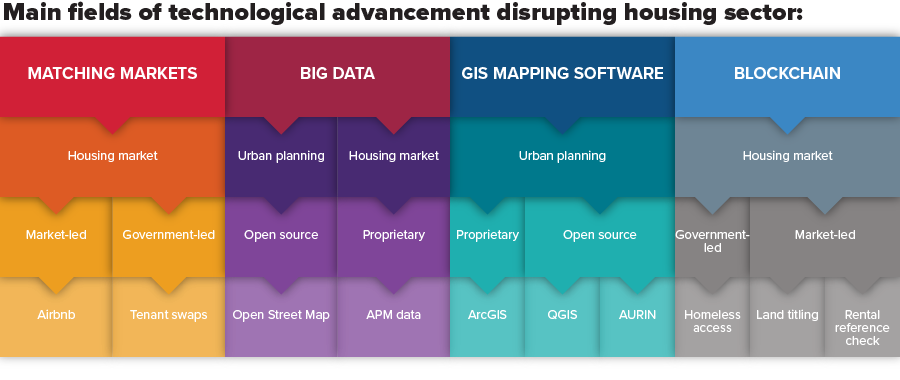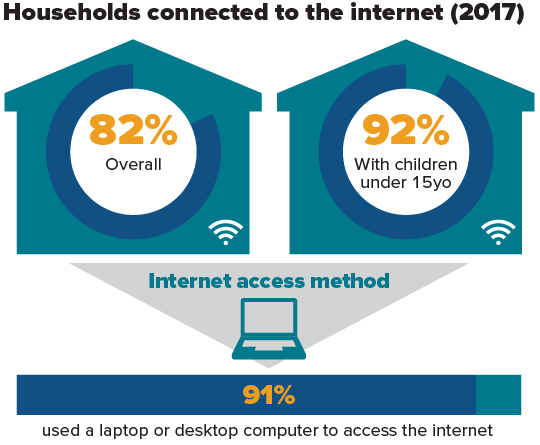Disruptive digital technologies are resulting in widespread innovation and transformation across many sectors and industries, requiring rapid reskilling and adaptation. The development of smart cities which integrate physical, digital and human systems in the built environment, is changing the ways that people live and work in cities, re-shaping property markets, and the way our cities are built and governed.
Digital connectivity is widely recognised as an important mechanism for economic growth, linking activities in cities across the world. The Federal Department of Infrastructure, Transport, Regional Development and Communications sees connectivity as ‘Enabling all Australians to connect to effective communications services and technologies, for inclusiveness and sustainable economic growth.’ Exclusion from accessing these technologies can exacerbate existing socio-economic disadvantage.
This Brief on ‘Digital Transformations’ considers the current status of the digitisation of Australia, presenting key issues including the digital infrastructure, smart cities technologies, data governance and digital inclusion.
Internet connectivity
The growth of the digital economy relies on fast and reliable telecommunications infrastructure. The National Broadband Network (NBN), which will be complete in 2020, has been rolling out across Australia since 2010. To date, 7.1 million homes and businesses are connected to the network. The system provides a mix of high speed fibre and existing copper wire connections, fixed wireless and satellite technology. Recent research found that in Australia’s three largest cities, Melbourne, Sydney and Brisbane, around half of households connected to the NBN are serviced by slower, outdated coaxial copper connections, rather than high speed fibre.
Despite considerable investment in the NBN, there remain questions about whether it is fit-for-purpose. Australian fixed line download speeds rank 67th in the world, with the average download speed of 51.61 Megabits per second compared with a global average of 78.26Mbps for fixed line services (June 2020). The Bureau of Communications and Arts Research found the network was adequate to cope with future demand, forecasting an increase in household data demand from 95 gigabytes per month in 2016 to 420 gigabytes in 2026. However, these estimates likely need to be revised.
The physical distancing measures in response to the COVID-19 pandemic have resulted in a 26% increase in online activity during business hours in Australia; people have rapidly adapted to working, studying and shopping online and many of these changes may become permanent.
Australia is in the early stages of upgrading to 5G mobile networks, the next generation of mobile broadband network which offers significantly faster download and upload speeds, and is now available in some parts of Australia. Fixed-wireless broadband connections to homes may also be provided by the 5G network in some places, and it remains to be seen how this will interact with fixed line services through the NBN. The 5G network will be enable greater use of smart technologies, because it offers faster wireless connection to the internet.
Despite considerable investment in the NBN, there remain questions about whether it is fit-for-purpose. Australian fixed line download speeds rank 67th in the world,
Smart technologies
Smart technology refers to devices that have inbuilt sensors, capacity for real-time data collection and enable wireless access and remote operation; these devices are connected through networks that comprise the Internet of Things. The Internet of Things is understood as ‘an infrastructure of interconnected entities, people, systems and information resources together with services which process and react to information from the physical world and from the virtual world’. This can include devices and sensors in homes and buildings, smart energy meters, environmental sensors tracking pollution and noise, smart travel cards, digital surveillance in cities and numerous other examples. The data collected by these devices has the potential to transform industries and inform a range of decisions about the management of systems within cities including water, energy and transport. Smart technology is identified as one of the three pillars of the Federal Government’s Smart Cities Plan, which emphasises its role in enhancing energy efficiency and other sustainability initiatives. To-date, the Smart Cities and Suburbs Plan has funded 82 projects across Australia that use technology based solutions to urban challenges, some examples are autonomous vehicles, interactive planning, active transport urban heat maps, and energy efficiency innovation using smart technologies.
The application of emerging technologies to real estate markets will also have direct relevance to the development of cities. ‘Proptech’ refers to technological innovations in acquisition, construction, development, zoning and planning, through to property management and sales. AHURI research has identified four main fields of technological advancement that are likely to disrupt the housing sector in future, or are already doing so: matching markets; big data; GIS mapping software; and blockchain. These new technologies offer the potential for significant innovation and disruption to traditional processes within these industries. Furthermore, the large quantities of data collected and stored through the application of these technologies has the potential to inform decision making in policy and business, and in itself, can become a form of property with its own commercial value.

Big data
Big data are large datasets, mined in bulk from a range of devices, which can be analysed to extract patterns of behaviour at both the macro and micro level. Access to this aggregate data offers significant opportunities for urban planners and policy makers; modelling techniques can utilise real-time information about infrastructure usage, flows of traffic and people, water and energy usage and various other systems within cities to support informed decision making and planning for the future. Many Australian state and local governments, and private enterprises have invested in ‘digital twin’ technology, such as the NSW Government’s Spatial Digital Twin, that will aggregate data and digital models from a wide range of sources to generate a 3D and 4D model of the city.
Nevertheless, the application of these new technologies raises important questions about surveillance, consent and civil liberties as our cities progress towards increasing uptake of smart technologies.
In the context of smart devices collecting and aggregating data about the movement of people within cities, important questions about privacy, data ownership and governance must also be considered. These issues were the subject of a Productivity Commission Inquiry in 2017 into data availability and use that considered both utility of these data sets for policy and industry, and also the risks associated with access to individuals’ private information, finding that Australia is not sufficiently advanced in this field. In response, the Australian Government appointed a National Data Commissioner to implement a new data sharing and release framework.
Nevertheless, the application of these new technologies raises important questions about surveillance, consent and civil liberties as our cities progress towards increasing uptake of smart technologies.
Digital inclusion
As essential services including health-care and education increasingly move online, access to these services will rely on access to the internet. The importance of digital connectivity has been starkly illustrated by the shift to online working a learning across Australia during the COVID-19 lockdown. The Australian Digital Inclusion Index shows that while digital inclusion is improving in Australia, socio-economic and locational disadvantages remain. In 2017, 82 per cent of Australian households overall, and 92 per cent of households with children under the age of fifteen, were connected to the internet. Of the connected households, 91 per cent used a laptop or desktop computer to access the internet, suggesting fairly widespread access to devices. However, this leaves a significant number of households (nearly 1.3 million in 2017) without access at home, and does not account for disparities between households in the affordability or quality of their digital connection and devices for accessing the internet.

Furthermore, a ‘digital divide’ exists for people in regional and remote Australia where internet services (and mobile phone services) are less accessible and reliable. Because of the size of Australia, and its dispersed population, regional broadband services often rely on less effective fixed wireless and satellite networks. These connections are more expensive, less reliable, restrict data, and are slower than fixed services. The improvement of internet connectivity to remote and regional areas is an identified policy priority; a place-based approach is being implemented through the Regional Connectivity Program, which provides grants to improve telecommunications infrastructure and support economic opportunities for communities in rural and regional locations.

